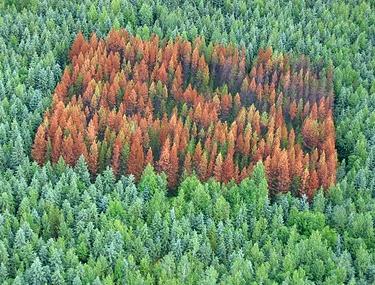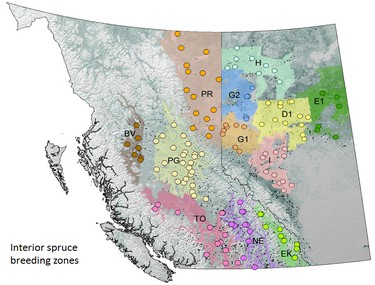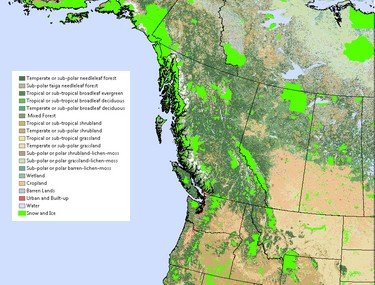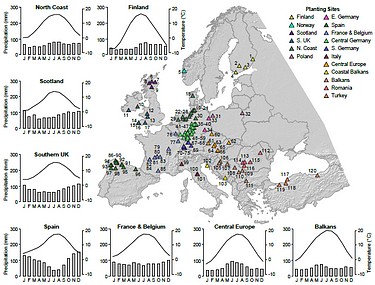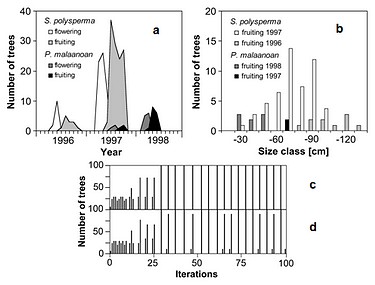Andreas Hamann's website
Current Projects | Completed Projects
Analyzing plant response to climate variability and climate change
Funded by Alberta Ingenuity and an NSERC Discovery Grant, we pursue a variety of historical biology research approaches to analyze and predict plant response to climate change. Elisabeth Beaubien, Logan Purdy, Jennifer Li, Nadele Flynn, Ashley Hynes and Vinicius Manvailer quantify the impact of climate variability and climate change using biological long-term records, including: (1) a 70-year spring flowering database for central Alberta from hundreds of observers, (2) remote sensing databases for North America, and (3) tree ring records from thousands of trees across the globe. This research is supported by our work on historical climate databases (below).
Selected publications, notes, news:






|
Funding: $165K 2015-2020, $290K 2007-2010 
 |
Forest tree growth and survival in response to climate extreme events
This research, funded by NSERC Strategic grants, combines dendrochronological analysis with genetic field trials to determine which genotypes are particularly well adapted to handle extremes of Canada's changing climate. Jaime Sebastian Azcona and Zihaohan Sang pursue dendroecological research in white spruce provenance and progeny trials, and Miriam Issac-Renton and David Montwé conduct whole-tree stem analysis in provenance trials destroyed by mountain pine beetle to (1) reconstruct annual heigt and volume growth, (2) retrospectively measure carbon sequestration and water use efficiency, and (3) analzye within-tree ring growth signatures in reponse to climate extremes.
Selected publications, notes, news:










|
Funding: $310K, 2012-2015; $310K, 2016-2019. 


|
Assessing the adaptive portfolio of forest trees for future climates
This project synthesizes results from provenance testing, genetic progeny trials, genomics data, and climate change modeling to select the best adapted populations and genotypes for reforestation programs. Katharina Liepe analyzed spatial patterns of phenotypic and genomic variation and identified adaptively unique populations that may be threatened by climate change. Laura Gray evaluated the adaptive portfolio of Alberta breeding populations and developed practical recommendations for reforestation under uncertain future climates. Zihaohan Sang synthesizes genetic and climate data for seed transfer prescriptions that address cliamte change.
Selected publications, notes, news:








|
Funding: $500K, 2011-2014; $200K, 2015-2016; $140K, 2016-2019.



|
Interpolated climate data for natural resource management
Virtually every study in the field of climate change impacts and adaptations requires long-term climate baseline data, records of past climate variability, and future predictions from general circulation models. In collaboration the University of British Columbia we maintain comprehensive and up-to-date climate databases (approximately 20,000 spatial coverages) and software to query those coverages. Get them here for North America, or Europe. Currently, Dante Castellanos Acuna works on developing equivalent databases for South America
Selected publications, notes, news:





|
Funding: $30K: 2006, 2008, 2011, 2013

 |
Completed Projects
Conservation of forest genetic resources in western North America
This project evaluates the conservation status of forest genetic resources in western North America through gap analysis. Erin Russell and Laura Gray conduct a detailed conservation inventory of current forest genetic resources for 50 forest tree species. Using the velocity of climate change approach, Quinn Barber and Dave Roberts identified vulnerable species and populations, but also climate refugia where habitat for locally adapted populations is maintained under a wide range of climate change scenarios. Jill Sekeli analyzes where to best place new protected areas to fill conservation gaps.
Selected publications, notes, news:



|
Funding: $90K, 2009-2012; $100K, 2013-2018.


|
Exotic forest tree plantations as a test-bed for predicting growth and survival under climate change
The central idea of this NSERC/Discovery research project is to use introductions of North American tree species to Europe, Australia and New Zealand as a test-bed for how these species may grow and survive under novel climatic environments. Miriam Isaak-Renton, Maria Herva and Ugbaad Kosar compare model-based habitat and growth projections for Douglas-fir, lodgepole pine, and jack pine against decades worth of growth data from European test plantations to evaluate the realism of our growth and habitat projections under climate change. In a collaboration with CSIRO, Katharina Liepe investigated adaptive genetic variation in radiata pine.
Selected publications, notes, news:




|
Funding: $160K, 2013-2018 

|
Climate change adaptation strategies for the forest sector
Adjusting seed zones and breeding programs to match planting stock to new climate realities is essential to maintain forest health and productivity. Laura Gray, Michael Mbogga, and Xianli Wang used climate modeling techniques and qunatitative genetic data to (1) predict future species habitat, (2) match genotypes with optimal planting environments, and (3) develop practical recommendations for reforestation under uncertain future climates.
Selected publications, notes, news:











|
Funding: $180K 2013-2016; $300K, 2007-2012 








|
Phenology, ecology, and management of Philippine Dipterocarp species
Dipterocarps, well known trees of the Southeast Asian rain forests, exhibit an unusual phenology. Mast fruiting events occur in irregular intervals of 2 to 10 years. This makes forest management and regeneration of this species group very difficult. Mariya Chechina tested whether a resource tracking model can explain and predict these phenological patterns. In addition the project aimed at understanding other ecological and silvicultural characteristics of this species group to support sustainable forest management.
Selected publications, notes, news:



|
Funding: $50K, 2009-2011; 30K 2012-2014

|

